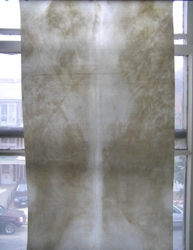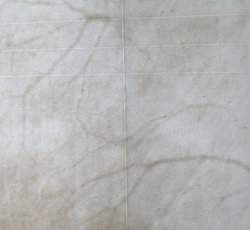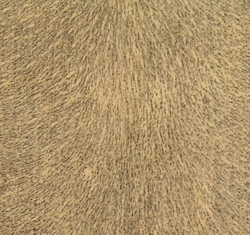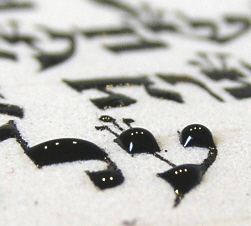Sunday, April 19, 2009
A Problem caused by an Excess of Liquid
Ink deciding to be blobby, and turning letters from agreeably three-dimensional into excessively three-dimensional. Photographed whilst still wet.
This image amuses me for three reasons. First, just because it's amusingly blobby. Second, because the letter on the right is letter ayin, which is a fountain kind of word, obviously the best letter to display excess liquid. Third, because it's in the story of the Flood, which of course was the archetypal problem caused by excess liquid.
Technical notes:
This sort of blobbing can be caused by variations in ink, pen, pen technique, klaf, atmosphere. Today the problem was the ink being rather too sticky - I'd left the lid loose on the inkwell over Pesach, so it had dried out a little bit and gone just sludgy enough that it behaved like this. Once I'd diluted it with a couple of drops of alcohol, it was fine. Barometer 30ins and rising slightly, temp mid-70s fahrenheit, humidity low 60%s. Leaving these as is may make them more prone to flaking decades in the future. You can sometimes sort it by blotting up the excess with blotting paper, but if the problem is sticky ink it won't blot well and you'll have to sort it later when it's dried by knifing off the excess. You should not do this in divine names.
Sunday, April 12, 2009
 This morning in the synagogue we read Exodus 13:9, which contains the phrase "The Torah of God shall be in your mouth."
This morning in the synagogue we read Exodus 13:9, which contains the phrase "The Torah of God shall be in your mouth."Rabbinic tradition expands this concept: if we are to put the Torah in our mouths, it obviously cannot be made of things that we may not eat. So all animal products used on Torahs are made from the kosher species.
Quills - swan or goose feathers, turkey or duck, but no peacock or ostrich, eagle or crow. Glue - before synthetic glues, sticky stuff was mostly made from animal products, did you know that? - fish glue or cow-hoof glue, but not rabbit-skin glue or horse-hoof glue. Thread, which is made from tendons and glue - cow tendons, but not horse tendons. And parchment.
Torahs are written on parchment, in Hebrew klaf, קלף, (with a kuf). Proper parchment is really a type of leather - here's a site which talks about how klaf is made. Nowadays most Torah parchment is made from cows, because the meat industry mostly deals with cows; older Torahs are often goat, one also sees deer and occasionally sheep; you could use bison, or chicken or turkey (but that would make very small pieces, and probably not be worth it). You could even use a giraffe, if you could find one.
And yes, I have this dream that one day someone will give me a dead giraffe and I will be able to write a Megillah on it, because you could fit the whole Megillah on one giraffe skin* and that would be unbelievably amazing so if you do know anyone with giraffes that are looking a bit tottery, do introduce me, or if you know a parchment-maker who's up for an adventure, likewise.
I digress.
The one kosher animal you may not use is a fish. Klaf can be made out of fishskin, but the rabbinic sources say that it smells truly terrible, and for that reason you can't use it for sacred scrolls - you don't want your holy books to be stinky. This I like very much.
Goat parchment retains a distinctive goaty tang for a Very Long Time - goats are like that, very assertive - and you can usually identify a goat Torah because it smells like a goat. I like this too, it is a pleasing reminder that the scroll is not just a text, it is a physical object as well.
The picture at right is a piece of klaf held up against a window. You can see very clearly where the cow's backbone was. Sometimes you can also see where the kidneys were, and if it had a fat bottom, sometimes you see that as well.

 The two images at left are close-ups of the surface of klaf. The top picture is the front side, and the bottom picture is the back side. A word about that, first: if you're processing parchment for a book, you make both sides the same, because you want to write on both sides of the page. But we only write on one side for our scrolls, so we only bother processing one side. That means that the front side is beautifully smooth and silky, almost like very very fine suede, but the back side is rougher and generally less "finished."
The two images at left are close-ups of the surface of klaf. The top picture is the front side, and the bottom picture is the back side. A word about that, first: if you're processing parchment for a book, you make both sides the same, because you want to write on both sides of the page. But we only write on one side for our scrolls, so we only bother processing one side. That means that the front side is beautifully smooth and silky, almost like very very fine suede, but the back side is rougher and generally less "finished."You can see that the front side has lines on it. All Torahs have to be written with lines - it's both a scribal aid, to keep the lines straight, and an halakhic (legal) requirement - i.e. even if you're really good at keeping your lines straight, you still have to have lines. You probably didn't notice them last time you read Torah, but they're almost certainly there - you just don't notice them because you're looking at the letters.
The lines are scored in. One can score one's own lines, with a ruler and some kind of scoring tool, such as an awl, or one can have the lines put in by the klafmachers (people who make the parchment). That's very clever - they have a grid of wires, and they set the wires to the appropriate positions, and then they press it hard into the klaf, bang, and that makes lines. Sort of like when your socks leave a line pattern in your ankle, only the klaf is dead so they don't fade away quickly like they do on ankles. Sometimes they will fade with extreme age, hence that "almost" above.
So anyway, on the front side of this particular piece you can also see the veins. The front side is generally bleached quite white and nice, but sometimes hints of animal-ness remain.
On the back side of this piece, you can see the hair pattern quite distinctly. The back will often keep some of the colour of the cow - greyish, brownish, whatever. Sometimes it's splotchy. I think that's rather lovely.
On most older scrolls, you won't see the splotching, because for a long time it was the fashion to paint the backs with a substance called log, to make them uniformly white. This undoubtedly makes the backs of the scrolls attractively white and shiny, but unfortunately it also makes the scrolls extremely heavy. Log is some variety of sticky substance mixed with some variety of white powder, for instance boiled klaf and powdered chalk, so when coating, you're effectively adding a layer of stone to the Torah, and of course that's going to be heavy.
So these days we don't coat the backs, we whiten the parchment by bleaching it, and any remaining discolouration serves to remind us of the complex relationship between animals and Jewish ritual worship. We generally get one sheet of parchment per cow, which works out to about sixty-five cows per Torah; that's a lot of cows.
I have explored the ethical implications of this in two related blog posts, here and here, but the intertwined ethics of the contemporary meat industry and the Jewish community's response have only just started to develop, so that particular aspect of Torah-making is one which will evolve in the direction we choose to take it.
Moadim le'simcha, as they say; continue to have an enjoyable matzah festival.
* Technically you would have to cut it into sheets because you mayn't have more than eight columns on a sheet, but that's okay, I'm very good at tiny neat seams, so the pattern wouldn't be too obviously disrupted.
Saturday, April 4, 2009
On starting to write
A bit about the day on which I started writing, and the portion I chose to write first.
This project is called Torat Imeinu, Our Mother's Torah, and I started writing on the sixth day of Nisan - the first month, the month of beginning, the month of finding identity, the month of discovering liberation. As it happens the sixth of Nisan was one year exactly since my student RHS lost her mother. RHS' friends made evening services at her place in the evening, and there was mac and cheese mom-style, and I went from there to the mikveh, the ritual bath.
The mikveh in this context symbolises beginnings, renewals, transitions. Immersing in a pool of mayim hayim, living waters, carries spiritual overtones in Jewish practice, so although there was no technical reason for me to go - no issues of ritual purity which bar one from writing Torah - it seemed appropriate.
The mikveh is life and the memorial service is death, and the Torah passes from generation to generation as life and death cycle by. Generations of mothers pass life to their daughters and fade with time, and generations of Torah scholars pass tradition to their students and fade with time, and me passing writing the Torah to my student RHS makes me part of the generations of scribes who have passed on the Torah, and I am on my way to fading in time also. I find this oddly consoling; it never was all about me, and being one link in a chain is more consonant with tradition than being the crest of a wave. Thus starting the journey for this Torah by remembering RHS' mom with her is profoundly beautiful in ways I cannot completely express, and they all swirled in my head while I was in the mayim hayim, the living waters flowing past and present from time gone by and times to come, mother to daughter, scribe to scribe, Jew to Jew, the waters of Torah swirling all around me and us and from that I wrote the first words of this newest Torah.
I chose to start with Sarah, the first matriarch, the Mother of all Jews. Converts to Judaism are given Sarah as their honorary mother. My own Hebrew name is Yonah Esther bat Sarah. The first piece I wrote was the moment of transition in Sarah's life, where she leaves her old name Sarai, princess, and becomes Sarah, in partnership with God. In this story, God tells Abraham that Sarah will bear him a son, and Abraham laughs in disbelief. Sarah laughs. Their son is named Yitzhak - Laughy. Sarah has wanted a son all her life and here her wish is granted. God will bless her, and through her Abraham and his descendants will become a great and populous nation, blessed by God and in covenant with God. For a Mother's Torah, this seemed a wonderful place to start writing.
I should perhaps explain that one does not have to write the Torah strictly sequentially. I started my first Torah with the Exodus story of the giving of the Torah, because it seemed appropriate. My second Torah was for Congregation Shir Tikvah (Song of Hope), and there is a verse in the Torah which self-referentially says "Write for yourselves this song," so that one I started at the beginning and wrote through to the end. Now I am writing with the Mothers in mind, so we are starting with Sarah.
It seems appropriate to finish with a nod to my own Mother. The Torah scroll is the foundation upon which Jewish identity stands; today's Jews have come a long way from the foundations but know that it is still there at the centre. My Mum believed that with a firm foundation at home, her children would be able to go far, and I jolly well did. Thanks, Mama. L'chaim.
This project is called Torat Imeinu, Our Mother's Torah, and I started writing on the sixth day of Nisan - the first month, the month of beginning, the month of finding identity, the month of discovering liberation. As it happens the sixth of Nisan was one year exactly since my student RHS lost her mother. RHS' friends made evening services at her place in the evening, and there was mac and cheese mom-style, and I went from there to the mikveh, the ritual bath.
The mikveh in this context symbolises beginnings, renewals, transitions. Immersing in a pool of mayim hayim, living waters, carries spiritual overtones in Jewish practice, so although there was no technical reason for me to go - no issues of ritual purity which bar one from writing Torah - it seemed appropriate.
The mikveh is life and the memorial service is death, and the Torah passes from generation to generation as life and death cycle by. Generations of mothers pass life to their daughters and fade with time, and generations of Torah scholars pass tradition to their students and fade with time, and me passing writing the Torah to my student RHS makes me part of the generations of scribes who have passed on the Torah, and I am on my way to fading in time also. I find this oddly consoling; it never was all about me, and being one link in a chain is more consonant with tradition than being the crest of a wave. Thus starting the journey for this Torah by remembering RHS' mom with her is profoundly beautiful in ways I cannot completely express, and they all swirled in my head while I was in the mayim hayim, the living waters flowing past and present from time gone by and times to come, mother to daughter, scribe to scribe, Jew to Jew, the waters of Torah swirling all around me and us and from that I wrote the first words of this newest Torah.
I chose to start with Sarah, the first matriarch, the Mother of all Jews. Converts to Judaism are given Sarah as their honorary mother. My own Hebrew name is Yonah Esther bat Sarah. The first piece I wrote was the moment of transition in Sarah's life, where she leaves her old name Sarai, princess, and becomes Sarah, in partnership with God. In this story, God tells Abraham that Sarah will bear him a son, and Abraham laughs in disbelief. Sarah laughs. Their son is named Yitzhak - Laughy. Sarah has wanted a son all her life and here her wish is granted. God will bless her, and through her Abraham and his descendants will become a great and populous nation, blessed by God and in covenant with God. For a Mother's Torah, this seemed a wonderful place to start writing.
I should perhaps explain that one does not have to write the Torah strictly sequentially. I started my first Torah with the Exodus story of the giving of the Torah, because it seemed appropriate. My second Torah was for Congregation Shir Tikvah (Song of Hope), and there is a verse in the Torah which self-referentially says "Write for yourselves this song," so that one I started at the beginning and wrote through to the end. Now I am writing with the Mothers in mind, so we are starting with Sarah.
It seems appropriate to finish with a nod to my own Mother. The Torah scroll is the foundation upon which Jewish identity stands; today's Jews have come a long way from the foundations but know that it is still there at the centre. My Mum believed that with a firm foundation at home, her children would be able to go far, and I jolly well did. Thanks, Mama. L'chaim.
Subscribe to:
Posts (Atom)




